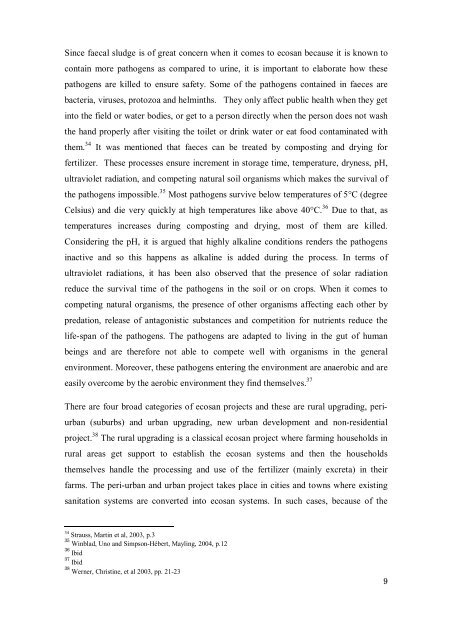A QUANTITATIVE APPROACH TO PREDICT ... - SuSanA
A QUANTITATIVE APPROACH TO PREDICT ... - SuSanA
A QUANTITATIVE APPROACH TO PREDICT ... - SuSanA
Create successful ePaper yourself
Turn your PDF publications into a flip-book with our unique Google optimized e-Paper software.
Since faecal sludge is of great concern when it comes to ecosan because it is known to<br />
contain more pathogens as compared to urine, it is important to elaborate how these<br />
pathogens are killed to ensure safety. Some of the pathogens contained in faeces are<br />
bacteria, viruses, protozoa and helminths. They only affect public health when they get<br />
into the field or water bodies, or get to a person directly when the person does not wash<br />
the hand properly after visiting the toilet or drink water or eat food contaminated with<br />
them. 34 It was mentioned that faeces can be treated by composting and drying for<br />
fertilizer. These processes ensure increment in storage time, temperature, dryness, pH,<br />
ultraviolet radiation, and competing natural soil organisms which makes the survival of<br />
the pathogens impossible. 35 Most pathogens survive below temperatures of 5°C (degree<br />
Celsius) and die very quickly at high temperatures like above 40°C. 36 Due to that, as<br />
temperatures increases during composting and drying, most of them are killed.<br />
Considering the pH, it is argued that highly alkaline conditions renders the pathogens<br />
inactive and so this happens as alkaline is added during the process. In terms of<br />
ultraviolet radiations, it has been also observed that the presence of solar radiation<br />
reduce the survival time of the pathogens in the soil or on crops. When it comes to<br />
competing natural organisms, the presence of other organisms affecting each other by<br />
predation, release of antagonistic substances and competition for nutrients reduce the<br />
life-span of the pathogens. The pathogens are adapted to living in the gut of human<br />
beings and are therefore not able to compete well with organisms in the general<br />
environment. Moreover, these pathogens entering the environment are anaerobic and are<br />
easily overcome by the aerobic environment they find themselves. 37<br />
There are four broad categories of ecosan projects and these are rural upgrading, periurban<br />
(suburbs) and urban upgrading, new urban development and non-residential<br />
project. 38 The rural upgrading is a classical ecosan project where farming households in<br />
rural areas get support to establish the ecosan systems and then the households<br />
themselves handle the processing and use of the fertilizer (mainly excreta) in their<br />
farms. The peri-urban and urban project takes place in cities and towns where existing<br />
sanitation systems are converted into ecosan systems. In such cases, because of the<br />
34 Strauss, Martin et al, 2003, p.3<br />
35 Winblad, Uno and Simpson-Hébert, Mayling, 2004, p.12<br />
36 Ibid<br />
37 Ibid<br />
38 Werner, Christine, et al 2003, pp. 21-23<br />
9
















